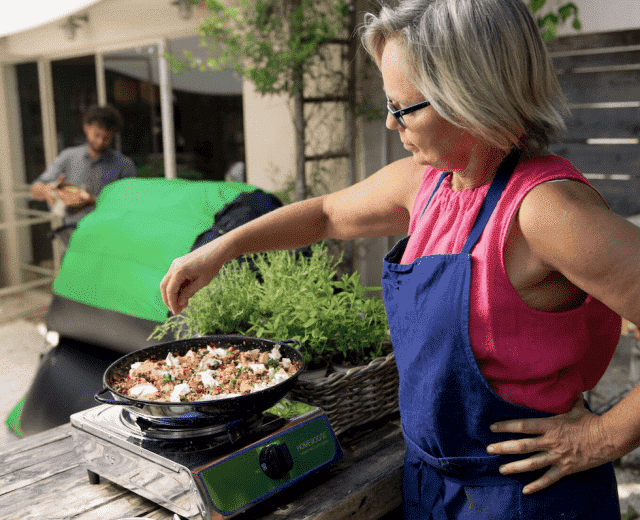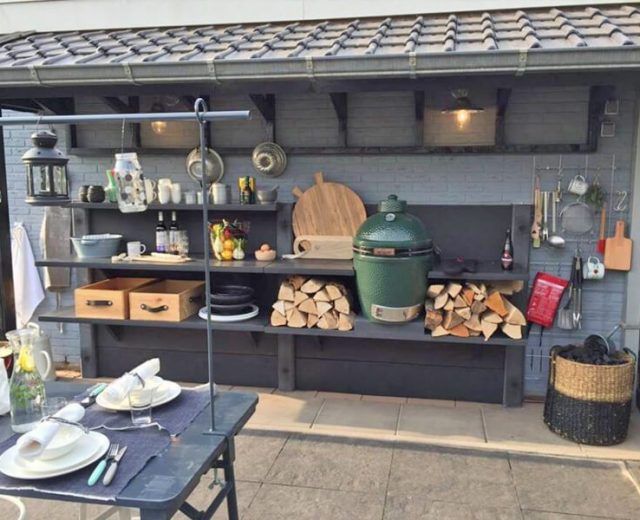
This May, the HomeBiogas team headed to the home of chef and MY OUTDOORS owner Michal Koren! Michal loves her HomeBiogas system, and she offered to cook us a meal to show it in action.
A graduate of the Technion program in landscape architecture, Michal loves to teach people to see the intersection of food and the outdoors. Michal and her husband work with their MY OUTDOORS family to design and construct beautiful, natural outdoor kitchens so that families can come together to experience their food in their own yards.
Michal’s outdoor kitchens go beyond mere grills; she designs them to be comfortable and easily accessible, to work in any weather condition, and to be well integrated into the existing design of the house.
Michal believes that as good as her food tastes, and as beautiful as her kitchens are, the thing that truly brings together a meal is the people present.
Because of her love of the outdoors, Michal knows how important it is to cook as sustainably as possible. That’s why she chose to install her own HomeBiogas system: so she could cook on gas that’s renewable, sustainable, and contributes to a solution for food waste.
Michal decided to test her recipe for paella on her HomeBiogas stove using just biogas from the system. She carefully chose a round rice variety and got to work frying tomatoes, garlic, and chopped pepper into a delicious sofrito on a pan above the blue HomeBiogas flame. (And of course, she remembered to set aside the garlic peels and pepper scraps to feed her HomeBiogas system after the meal!)
Michal told us that the sound of the sizzling vegetables meant the paella was cooking perfectly. “The process is incredibly smooth,” she added as she drizzled olive oil over the pan.
Michal continued to cook, adding in the rice and cooking it until it turned into a crispy bottom layer for her paella. As she cooked, she admired the way she could adjust the flame to the perfect temperature for the dish. “Vegetarian paella actually needs a pretty high temperature, and I like to go back and forth in phases with a moderate heat,” she told us. “The ability to play with the heat height is really giving the best results.“
After sharing the delicious meal together in Michal’s backyard, we fed the machine with the food scraps from our paella. Michal was so proud to have used biogas for her paella, and she plans to continue using her system to cook in her outdoor kitchen!
“HomeBiogas is a great addition to my backyard, and we use it on a daily basis,” she said. “We cook a lot at home and use a lot of natural ingredients, and it feels great knowing that my waste and scraps of food and leftovers are a part of producing my gas.”
And lucky for us (and for you), Michal was happy to share the recipe for that scrumptious paella. Enjoy!
Recipe for Vegetarian Paella with Goat Cheese
(Make 6-8 servings)
Ingredients:
- 3.5 cups hot vegetable stock (can be any combination of herbs/seasonings, like rosemary and basil)
- 4 tomatoes, peeled and coarsely chopped
- 4 handfuls of fresh spinach (you can also use chard or rocket)
- 1 red pepper, chopped
- 1 jar (580 mg) of quartered artichokes in oil or filtered salt water
- ¼ cup olive oil
- 2 cups round rice (either for paella or regular), washed and filtered
- 150 grams of goat cheese (Saint-Maure, Promaz, or Bosha)
- 5 cloves of garlic
- 1 medium onion (around 120 grams)
- 2 tsp (flattened) smoked paprika
- Salt and pepper
Instructions and Tips:
Use a Spanish pan with handles on the sides that can be moved to the oven when necessary. If you don’t have one, paella cooks best on a pan with a thick bottom.
Cover: Unlike most rice dishes, paella does not need to be covered while cooking. You can cover it for a minute or two at the end if you think the rice needs to soften more.
At first, you can use a wooden spoon to mix, but make sure not to overdo it because the rice needs to get hot.
In Spain, they use a special circular rice variety called Bomba or Goya. It’s a grain that absorbs fluid well while protecting the integrity of the grain. It may be hard to get where you live; you can just use Arborio rice. Avoid using long varieties like jasmine, basmati, or sushi rice because they will not cook well with this technique. Cook the rice for 20 minutes until the grains are almost soft (al dente). The ultimate test for paella is the taste of the rice–if everything else is eaten and only rice remains in the pan, you’ve failed.
You can’t start without the olive oil. The rice absorbs the olive oil during the light frying in the beginning of preparation, along with the sofritos. Use extra virgin olive oil.
Cooking classic paella begins with frying the crushed tomatoes, garlic, and chopped pepper, known as sofrito. Fry until you get a thick mash, in which you will cook the rice. The sofrito changes depending on the paella recipe. Wine is not required, but you can add some white wine to the sofrito before it evaporates. Taste it before adding the rice.
The best cooking liquid is a hot broth, which tastes good with the rest of the ingredients. Most recipes use chicken or fish, but it’s possible to use beef, vegetable, or squid broth for a black paella. If you don’t have broth, you can use vegetable juice or soak dried mushrooms or sun-dried tomatoes. The broth is usually seasoned with saffron and/or turmeric, which will color the rice yellow. The ratio of liquid to rice is 6 ml (2½ cups) of broth to 400 grams (2 cups) of rice. If you need to, add more broth.
The roasted layer of rice at the bottom of the pan (the Spanish equivalent of the Persian “socarrat” and Thai “crispy rice”) is one of the ingredients in the paella. If you want to make it crispier, put the pan in an oven at 200-220°C for 10 minutes to make it crispier from above.
Last touch: before removing the chopped parsley and serving, provide some lemon wedges so that each guest can squeeze some on.









